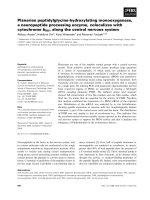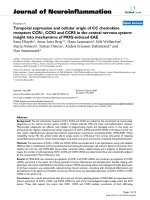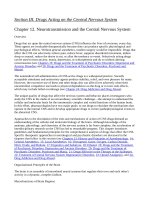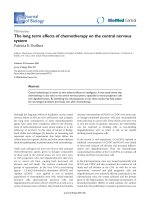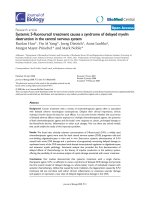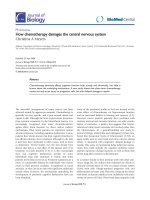INVESTIGATION OF MEMBRANE PROPERTIES IN THE CENTRAL NERVOUS SYSTEM OF DROSOPHILA MELANOGASTER STUDIED BY FLUORESCENCE CORRELATION SPECTROSCOPY
Bạn đang xem bản rút gọn của tài liệu. Xem và tải ngay bản đầy đủ của tài liệu tại đây (2.04 MB, 78 trang )
INVESTIGATION OF MEMBRANE PROPERTIES IN THE CENTRAL
NERVOUS SYSTEM OF DROSOPHILA MELANOGASTER STUDIED
BY FLUORESCENCE CORRELATION SPECTROSCOPY
TEO LIN SHIN
(B. Appl. Sci. (Hons.), NUS)
A THESIS SUBMITTED
FOR THE DEGREE OF MASTER OF SCIENCE
DEPARTMENT OF CHEMISTRY
NATIONAL UNIVERSITY OF SINGAPORE
2012
Acknowledgements
I graduated with a bachelor degree in applied chemistry. Hence, it is a great
challenge for me to involve in biological work for my graduate studies. Firstly, I
would like to acknowledge the guidance and support from my main supervisor, A/P
Thorsten Wohland, and my co-supervisor, A/P Rachel Kraut. I am grateful to my
colleagues from the Biophysical Fluorescence Laboratory in NUS, in particular Foo
Yong Hwee for guidance in technical issues, Shi Xianke for useful advices and Manna
Manoj for helpful discussion. I am thankful to my colleagues from the Biological
Sciences Laboratory in Nanyang Technological University (NTU). I would like to thank
my attachment student, Willcyn Tan, for preparing the primary cultures in this work.
I would like to thank Dr. Jesuthasan from Neuroscience Research Partnership
(A*STAR) for accommodating me in his laboratory during my stay there, and A/P
Christoph Winkler for allowing me to use his fluorescent microscope. I want to
express my gratitude to my parents for their unconditional love, support and
understanding. Finally, I would like to thank God for wisdom and aid in times of need.
This work was partially carried out in NTU, Institute of Bioengineering and
Nanotechnology (A-STAR), and Neuroscience Research Partnership (A*STAR).
i
Table of Contents
Acknowledgements……………………………………………………………………………………………………i
Table of Contents………………………………………………………………………………………………………ii
Summary………………………………………………………………………………………………………………….iv
List of Tables…………………………………………………………………………………………………………….vi
List of Figures and Illustrations………………………………………………………………………………..vii
List of Symbols and Acronyms………………………………………………………………………………….ix
Chapter 1.
Introduction………………………………………………………………………………….....1
Chapter 2.
Theory and methods…………………………………………………………………………9
2.1.
Fluorescence Correlation Spectroscopy…………………………………………….9
2.1.1. The FCS Concept and Autocorrelation Analysis…………………….10
2.1.2. Theoretical ACF Models……………………………………………………….14
2.2
FCS Instrumentation………………………………………………………………………..19
2.3
System Calibration…………………………………………………………………………..21
2.4
Application of FCS to Study Plasma Membrane Dynamics……………….23
Chapter 3.
Biological Sample Preparation………………………………………………………..27
3.1
Genetic Crosses for Fruit Fly (Drosophila melanogaster)
Embryos…………………………………………………………………………………………..27
3.1.1 Recovering Meiotic Crossover of RRa Driver and
rFlotillin-2-EGFP Reporter……………………………………………………..27
3.1.2
Diffusion Behaviour in Different Subcellular Locations…………29
3.1.3 Diffusion Behaviour in Plasma Membranes with Different
Lipid Composition………………………………………………………………..31
3.2
Embryo Preparation for FCS Measurements…………………………………….34
3.3
Primary Culture Preparation for FCS Measurements…………………….…38
ii
3.3.1
Genetic Crosses for Drosophila Larvae………………………………….38
3.3.2
Primary culture preparation from larval brains…………………….39
Chapter 4.
FCS Study in situ in Fruit Fly (Drosophila melanogaster) Embryo
and Primary Cultures ………………………………………………………………………41
4.1
Statistical Analysis……………………………………………………………………………41
4.2
Distinct Diffusion Properties in Different Subcellular Locations……….45
4.3
FCS Study on Neuronal Membrane Dynamics in situ in
Drosophila melanogaster Embryo and Larval Primary Cultures………..47
Chapter 5.
Conclusion and Outlook………………………………………………………………….56
5.1
Conclusion……………………………………………………………………………………….56
5.2
Future Outlook……………………………………………………………………………….57
Bibliography…………………………………………………………………………………………………………...59
Publication.…………………………………………………………………………………………………………….66
iii
Summary
The objective of this study is to apply biophysical fluorescence technique, i.e.
fluorescence correlation spectroscopy (FCS), in situ in the central nervous system of
fruit fly (Drosophila melanogaster) embryo to study plasma membrane dynamics.
We showed that fluorescent proteins exhibited distinct diffusion properties
depending on different subcellular locations. Then we altered the membrane lipid
composition by genetic and pharmacological manipulations that should change
membrane fluidity. The changes in membrane sphingolipid composition or
microenvironment were reflected in the diffusion behavior of the membrane probes
employed. To our knowledge, this is the first time that neuronal membrane fluidity
was being studied in situ in the central nervous system of Drosophila melanogaster
embryos by FCS. Our approach promises to shed light on the biophysical features of
cellular membranes in fly mutants or disease models in which membrane dynamics
or regulation of lipid composition may play a part in the development and
pathogenesis of diseases, e.g. in neurodegenerative diseases, lipid storage diseases
and other lipid metabolic disorders.
Chapter 1 provides an overview of the driving force and motivation for this
study. The membrane probes used in this work are also introduced. A brief
introduction of the model organism, Drosophila melanogaster, is also given.
Chapter 2 introduces the concepts and theory of FCS as well as the
experimental setup of this instrument. The calibration of the FCS system is also
discussed. The last part of this chapter presents necessary and critical steps in
applying FCS to study plasma membrane dynamics such as laser power selection to
iv
minimize photobleaching and saturation while obtaining optimal molecular
brightness for good signal-to-noise ratio, vertical positioning of the focal volume in
the membrane, neuronal cell selections and treatment of recorded data
(autocorrelation curves).
Chapter 3 describes the procedures of biological sample preparations
including fly genetic crosses, fruit fly embryo preparation for imaging and
measurements, and larval primary culture preparation. Necessary steps for the
success of FCS measurements in fruit fly embryos such as adjustment of the number
of copies of GAL4 driver and reporter, embryo aging temperature, and the removal
of autofluorescence interference were also described.
Chapter 4 presents the results and discussion of FCS measurements in both
the fruit fly embryos and in larval primary cultures. The statistical analysis employed
was discussed. The purpose of these experiments was to compare the mobility of
membrane probe obtained in situ in embryonic neurons vs. that of neurons obtained
from larval primary brain cultures.
Chapter 5 concludes and presents future outlook for plasma membrane
dynamic studies in fruit fly embryos.
v
List of Tables
Table 4.1
Diffusion coefficients of mCD8-EGFP and cytoplasmic EGFP
measured in different subcellular locations
47
Table 4.2
Diffusion coefficients of rflotillin-2-EGFP measured in
Drosophila embryos and larval primary cultures under
different conditions
52
Table 4.3
Diffusion coefficients of mCD8-EGFP measured in
Drosophila embryos under different conditions
55
vi
List of Figures and Illustrations
Fig. 2.1
Schematic drawing of a confocal FCS instrumental setup
20
Fig. 3.1
Genetic crosses for recovering crossover of RRa driver and
rFlotillin-2-EGFP reporter on the third chromosome after
genetic recombination
28
Fig. 3.2
Fluorescence image of a larval brain from third instar larva
with genotype RRa,rFlotillin-2-EGFP/RRa,rFlotillin-2-EGFP (III)
29
Fig. 3.3
Genetic crosses for the study of diffusion behaviour in
different subcellular locations of the Drosophila embryo
30
Fig. 3.4
Genetic crosses for rflotillin-2-EGFP to generate embryos
with different membrane lipid composition
31
Fig. 3.5
Genetic crosses for rflotillin-2-EGFP for FCS measurements
on the bottom membrane (membrane nearest to the cover
glass bottom)
33
Fig. 3.6
Genetic crosses for mCD8-EGFP to generate embryos with
different membrane lipid composition
33
Fig. 3.7
Drosophila embryo preparation for FCS measurements
35
vii
Fig. 3.8
Confocal images of aCC motor neurons in dissected
Drosophila embryos before and after labeling with 10µM
SYTOX Green stain.
37
Fig. 3.9
Genetic crosses for rflotillin-2-EGFP to generate larvae
with different membrane lipid composition
38
Fig. 4.1
X-Y, X-Z, Y-Z cross-sectioning display of aCC and RP2 motor
neurons in a dissected stage-16 embryo
45
Fig. 4.2
ACF curves of FCS measurements in different subcellular
localizations in the Drosophila embryo
46
Fig. 4.3
The average diffusion times ± standard error of the mean
(SEM) of rflotillin-2-EGFP in Drosophila embryos and larval
primary cultures under different conditions
50
Fig. 4.4
Distribution of rflotillin-2-EGFP diffusion times (within
3 standard deviations of the mean) in Drosophila embryos
and larval primary cultures under different conditions.
51
Fig. 4.5
The average diffusion times ± standard error of the mean
(SEM) of mCD8-EGFP in Drosophila embryos under
different conditions.
53
Fig. 4.6
Distribution of mCD8-EGFP diffusion times (within 3 standard
deviations of the mean) in Drosophila embryos under different
conditions.
54
viii
List of Symbols and Acronyms
Aβ
amyloid β-peptide
ACF
autocorrelation functions
AD
Alzheimer’s disease
APP
amyloid precursor protein
CDase
ceramidase
CPM
photon counts per molecule per second
DMSO
dimethyl sulphoxide
DNA
Deoxyribonucleic acid
DRM
Detergent resistant membrane fractions
EGFP
enhanced green fluorescence protein
ESD
extreme studentized deviate test
FCS
fluorescence correlation spectroscopy
HL3
haemolymph-like solution
HMGR
Hydroxymethylglutaryl-CoA reductase (enzyme)
mβCD
methyl-β-cyclodextrin
mCD8
mouse lymphocyte protein CD8
ix
nSMase
neutral sphingomyelinase
PBS
phosphate buffered saline
PS
presenilin
rFlot2
rat flotillin-2
siRNA
small interfering ribonucleic acid
SMase
sphingomyelinase
TLC
thin layer chromatography
UAS
upstream activating sequence
x
Chapter 1
Introduction
Cell membranes are complex in composition and are dynamically
compartmentalized by cytoskeleton and lipid domains (rafts) to coordinate the
bioactivity of membrane constituents [1, 2]. Cell membranes are no longer thought
of as a homogenous sea of lipids with randomly arranged membrane proteins but
are composed of fluctuating nanoscale assemblies of sphingolipids, cholesterol and
specific proteins (<120 nm in diameter) which have diffusion timescale of tens to
hundreds of miliseconds [3]. Upon activation, these nanoscale assemblies (also
called rafts or membrane microdomains) can coalesce to form more stable platforms
in the functionalized state [1, 2]. Fluorescence correlation spectroscopy (FCS) is a
sensitive photon counting method to study the biophysical features of the plasma
membrane. It was first introduced in the 1970s by Magde et al [4] and further
optimized in the 1990s by Rigler et al [5]. This technique is based on collecting the
fluorescence intensity fluctuations of molecules passing through a small illuminated
observation volume. Then by applying a mathematical process called autocorrelation
analysis to the recorded fluorescence signals, one can extract parameters such as
local concentrations, molecular mobility and photophysical dynamics of the
fluorescent molecules. In principle, any processes which cause fluorescence intensity
fluctuations that are slower than the recording speed of the instrument (between
nanoseconds to miliseconds) can be studied by FCS. Previous FCS measurements
showed that membrane raft markers which associate with these nanoscale
1
assemblies displayed slower overall mobility compared to non-raft localizing markers
in mammalian cell cultures. The disruption of these rafts by cholesterol depletion
augmented the mobility of raft markers but not those of non-raft markers [6, 7].
Most intracellular measurements using FCS are performed in vitro in 2D cell culture
systems [8-12] and model membranes [13-16]. Although the experimental settings of
cell lines and model membranes are tightly controlled, their physiological relevance
remains unclear. The insufficiency of 2D cell culture to mimic physiological tissue is
exemplified by the deregulation of a receptor which is responsible for virus infection
in 2D cell culture where the integrity and polarity of 3D organization were disrupted
[17]. In this regard, it is desirable to extend FCS studies in situ in a model organism
where cells are embedded in their native 3D environment.
Herein, we use Drosophila melanogaster embryo as a model to study neuronal
membrane fluidity. To our knowledge, this is the first time confocal FCS is being used
to study membrane fluidity in situ in the central nervous system of Drosophila
melanogaster embryos. A study by Sergent et al. indicated that increased plasma
membrane fluidity increased the susceptibility of the membrane to oxidative
damage in hepatocytes isolated from rats [18]. Rao et al also demonstrated that fly
mutants for dCERT (ceramide transfer protein, which is required for ceramide to be
transported from Golgi to the plasma membrane) displayed > 70% decrease in both
ceramide and ceramide phosphoethanolamine (the sphingomyelin equivalent in
Drosophila) levels, and led to increased plasma membrane fluidity [19]. However,
their polarization studies were not done in situ but were done in total membranes
that were extracted from flies.
2
Oxidative stress is widely recognized as being an important factor in the
pathogenesis of neurodegenerative diseases [20]. Earlier reports showed that brains
from Alzheimer’s disease (AD) patients contain elevated levels of ceramide
compared to normal patients [21-24], possibly mediating oxidative stress-induced
neuronal apoptosis. Including ceramide, other sphingolipids and raft-associating
lipids, like sphingomyelin, gangliosides and cholesterol also strongly affect amyloid
precursor protein (APP) processing for amyloid β-peptide (Aβ) generation, which is
responsible for the formation of senile plaques in the brain of AD patients [25-27].
About 75% of human disease genes have a highly homologous direct equivalent in
Drosophila melanogaster [28, 29]. This makes the fruit fly (Drosophila melanogaster)
an ideal model system to study the biophysical features of neuronal plasma
membranes since a wealth of genetic resources is available for introducing nearly
any gene in any desired tissue or specific cells such as particular neurons. The
nervous system of Drosophila has been thoroughly described throughout its
development and each motor neuron has a stereotyped position, connectivity, and
identity [30]. With the UAS-GAL4 system of inducible gene expression [31], we can
express fluorescently tagged membrane probes and simultaneously manipulate
membrane lipid composition in a spatially and temporally controlled manner in
Drosophila. Hence, this allows us to study the changes in neuronal plasma
membrane fluidity due to genetic manipulations of membrane lipid compositions.
As in mammals, membrane lipids in Drosophila melanogaster preserve the
biophysical properties necessary for membrane domain formation, i.e. sphingolipids
have longer and more saturated fatty acids than those of phospholipids [32].
3
Rietveld et al showed that the membranes of Drosophila embryos contain detergent
resistant membrane fractions (DRM) which are also rich in sterols, sphingolipids,
glycosphingolipids and glycosylphosphatidylinositol-linked proteins similar to
mammalian cells, allowing us to study raft related processes in Drosophila embryos.
It is often necessary to use embryos as an experimental object when studying the
phenotypic consequences of genetic mutations, as certain mutations are potentially
devastating or lethal in later stages. Unlike the mammalian plasma membrane, the
Drosophila membrane contains phosphoethanolamine ceramide (PE-cer) as the
major constituent instead of sphingomyelin (PE-cer has phosphoethanolamine as the
head group, instead of the phosphocholine head group in SM) [32]. Despite having
shorter fatty acyl chains (the longest being C18), Drosophila phospholipids contain
the same head groups as mammalian cells (phosphoethanolamine, phosphocholine,
phosphoserine and phosphoinositol). Drosophila’s sphingolipids also contain a
shorter acyl chain on the sphingoid base than those in mammalians. The reason for
this may be that Drosophila being cold-blooded maintains a body temperature
comparable to that of their surroundings, i.e. 18-25 °C.
In our study, we use a putative raft protein, rat flotillin-2 which was C-terminally
tagged with a fluorophore, EGFP [33], as a membrane raft probe. It has been
extensively studied as a raft localized marker in Drosophila. Flotillin is ubiquitously
expressed and evolutionarily conserved among species. This protein is involved in
various cellular processes such as epidermal growth factor receptor signalling,
regulation of the actin cytoskeleton and cell-matrix adhesion [34, 35]. Interestingly,
Schneider et al reported a role of flotillin-2 in APP processing [36]. They showed that
4
siRNA downregulation of flotillin-2 impaired APP endocytosis and reduced Aβ
production. Flotillin-2 formed noncaveolar micropatches (domains) in both neuronal
and nonneuronal cells, and immunostaining of cells required permeabilization of the
membranes, suggesting inner leaflet localization [33, 37] or that it is embedded in
the plasma membrane. It was shown that flotillin-2 required both lipid modifications
(myristoylation and multiply palmitoylation) and oligomerization to be in the DRM
[33]. The fluorophore, EGFP, enabled genetic labelling of proteins (in this work,
flotillin-2) in a selective and specific manner. This membrane raft marker was used
by us to study the effect of manipulating lipid composition on membrane fluidity in
motor neurons of Drosophila embryos.
As a comparison, we used another membrane probe that is not known to be
specifically raft-localized, to show the difference in diffusion behaviour on the
membrane. For this, we used the common membrane marker, mCD8 that was Cterminally tagged with EGFP, which is often used to label cell populations in
Drosophila. mCD8 is a full length alpha polypeptide of the mouse lymphocyte protein
CD8 [38, 39] and a member of the immunoglobulin supergene family [40]. It is
thought to function as a T cell receptor corepressor to negatively regulate T cell
activation [41]. It is a transmembrane protein consisting of a signal peptide sequence,
an N terminal external domain, a hinge region nearest to the membrane, a
hydrophobic transmembrane segment, and a basic intracytoplasmic tail [38]. Besides
flotillin, it is the only membrane marker being stably expressed in the flies in our
studies. Like human CD8, the homodimers of mouse CD8 alpha chains did not
associate with the DRM fractions isolated from mouse cell lines [42, 43], suggesting
5
that CD8 in mammals is a non-raft localizing protein. Assuming CD8 behaves similarly
in flies, we used this construct as a non-raft membrane probe in this study.
Here, the stage-16 Drosophila embryos shortly post-completion of central nervous
system development were dissected and cells of interest i.e. motor neurons in the
ventral nerve cord were exposed for FCS measurements. With a suitable promoter,
we were able to express fluorescent proteins in motor neurons which were situated
very close to the cover glass. This minimized spherical aberration and refractive
index mismatch as these effects became more severe with increasing focal depth.
Autocorrelation curves obtained from the membrane and cytoplasm showed
diffusion times that correspond to the probes’ subcellular locations, with membrane
localized protein showing longer diffusion time than those freely diffusing in the
motor neurons. In this project, we demonstrated the application of FCS in Drosophila
embryos, showing that it was possible to use confocal FCS to measure reliably the
characteristic diffusion behaviour of fluorescent proteins, and that this diffusion
behaviour depended on subcellular location.
It was important before beginning the genetic experiments that we first established
that FCS could be used to measure mobility of GFP expressing markers in situ in
Drosophila embryos, and that differently localized proteins behaved in a manner
specific to their subcellular localizations. After successfully describing this, we used a
suitable promoter and the UAS-GAL4 system to attempt to introduce genetic
changes which should affect the membrane lipid composition in Drosophila embryos
in a specific and predictable way. In order to achieve this, we expressed neutral
ceramidase (CDase) [44, 45] and neutral sphingomyelinase (SMase) in specific motor
6
neurons. These genes in the fly are the homologs of their mammalian sphingolipid
catabolyzing counterparts. Ceramidase is an enzyme which catalyzes the hydrolysis
of ceramide to sphingosine. Ceramide is the simplest form of sphingolipid and was
shown to promote clustering of nanoscale domains in supported lipid bilayers [46]
and in cells during death signalling [47]. A neutral ceramidase homologue in
Drosophila which localizes on the third chromosome was first reported by Yoshimura
et al [48]. Transgenic flies which overexpress the ceramidase enzyme exhibited high
neutral ceramidase activity and decreased ceramide levels [44].
A neutral
sphingomyelinase homologue also exists in Drosophila which has been described to
hydrolyze phosphoethanolamine ceramide, the sphingomyelin homologue, to
release ceramide (FlyBase and Julie Saba, personal communication). P-element
insertions in this gene are available but have not been characterized. Here, we use
the EY00448 line which contains a P-element insertion in this gene at the sequence
location 3,220,873 on the left arm of the third chromosome (FlyBase). Liquid
chromatography Mass Spectrometry (LCMS) carried out by Dr. Kate Osborne
(postdoc in Dr. Kraut’s lab) together with our collaborator Dr. Sarita Hebbar in the
lab of Dr. Dominik Schwudke (NCBS, Bangalore) showed that this insertion
moderately increased total ceramide levels in Drosophila larval brains compared to
those without it (data not shown) suggesting overexpression of functional SMase. Dr.
Osborne in our laboratory also prepared our own SMase construct which exhibited
much higher total ceramide levels in brain upon overexpression, suggesting further
increased SMase activity than the EY00448 line (preliminary TLC results not shown).
In our studies, these treatments resulted in differences in membrane fluidity which
7
were reflected in the changes of diffusion behaviour of rflotillin-2-EGFP and mCD8EGFP. We also manipulated the membrane composition and mobility by
pharmacological manipulations using methyl-β-cyclodextrin (mβCD) and latrunculin
A. However, these treatments were only done for the study using rflotillin-2-EGFP.
mβCD is able to extract cholesterol (including other sterols) from fly neurons [6]
whereas latrunculin A disrupts the actin cytoskeleton thus releasing membrane
lipids/proteins from constraints that are imposed by physical barriers due to
membrane contacts to actin fibrils. Both cholesterol removal and actin
depolymerisation could alter the mobility of lipid raft probes in rat and human
neuronal cells [6, 49], making these good proof of principle experiments for us. We
also compared in situ FCS measurements from the top (nearer to ventral side of the
embryo) and bottom (nearer to the dorsal of the embryo) embryonic neuronal
plasma membranes and found that the general fluidity differed significantly between
these two membranes, without any genetical interference of lipid composition. We
suspect that this in situ membrane fluidity difference in embryos could be due to
neuronal apical-basal polarity. FCS measurements in larval primary cultures after
applying the same genetic manipulations of membrane lipid composition as in
embryos showed no difference in membrane fluidity. Possible factors such as altered
gene expression pattern [50], different cytoskeletal make-up, and cell identity
differences may swamp the difference in membrane fluidity in primary cultures.
8
Chapter 2
Theory and methods
2.1.
Fluorescence Correlation Spectroscopy
FCS was first demonstrated in 1972 by D. Magde, E. L. Elson and W. W. Webb [4] to
monitor the binding reaction between ethidium bromide and DNA. The principle of
FCS is based on detecting fluorescence fluctuations as fluorescent particles diffuse in
and out of an illuminated observation volume. Although FCS was applied successfully
to study this chemical reaction, the early FCS measurements suffered from poor
signal-to-noise ratio due to technical limitations. The breakthrough in FCS only came
in 1993 when Rigler et al. introduced a small pinhole in the image plane of their
confocal microscope illumination configuration and used a strongly focused laser
beam to produce a femtoliter-size observation volume [5]. The pinhole limited the
detection volume in the axial direction and blocked out-of-focus fluorescent light,
thereby provided axial resolution. The diffraction limited spot ensured that
fluorescence fluctuations from a small number of fluorophores (<10) were large
enough to yield good signal-to-noise ratio. Any processes which cause variations in
the fluorescence fluctuations could be studied by FCS, for example translational
diffusion, conformational changes, flow, photophysical processes or photochemical
reactions of fluorophores. The recorded fluctuations contain information which
could be extracted by performing an autocorrelation analysis to produce an
autocorrelation function (ACF). The experimental ACF can then be fitted with a
theoretical ACF model to determine local concentrations, diffusion coefficients, rate
9
constants of inter- or intramolecular interactions of fluorescently labelled probes. As
FCS is a versatile method, it has been applied to study various molecular dynamic
processes [51-58]. There are also more advanced types of FCS such as fluorescence
cross-correlation spectroscopy, total internal reflection FCS, two focus FCS, scanning
FCS, and single plane illumination FCS, each with its own advantages providing
flexibility to researchers to answer different scientific questions. In this study, a
standard confocal FCS setup was used for all measurements and its theory was being
discussed.
2.1.1. The FCS Concept and Autocorrelation Analysis
The probability of finding a discrete number of molecules in the focal volume is
governed by Poisson statistics as shown below [59]
N n e− N
P ( n, N ) =
n!
(2.1)
where P(n,N) is the probability of n fluorophores present in the focal volume when
the average number of molecules is N. When N = 0.5, the probability of detecting no
fluorophore in the focal volume, i.e. P(0,0.5), is 61 %. The probability of detecting 1
molecule in the focal volume is 30 % and for 2 molecules it is 8%. With increasing
average number, the probability of detecting few molecules decreases drastically.
Hence, it is important to keep the concentration and focal volume small enough in
order to detect few molecules so that the contribution of each to the measured
fluorescence signal is substantial. In Poisson statistics, the variance is equal to the
mean value. Therefore, the standard deviation (σ) is equal to the square root of the
mean value. Although it is important to minimize the number of molecules
10
occupying the focal volume, this has to be balanced against the fact that the
measured signal should still be higher than the background noise. The signal-to-noise
ratio is the ratio of mean value to standard deviation of the measured fluorescence
signals.
Signal N
= =
Noise σ
N
=
N
N
(2.2)
In a rule of thumb, the average number of molecules should be between 0.1 and
1000 [60]. As the fluorophores diffuse in and out the focal volume, there are
fluctuations in the detected fluorescence intensity over a period of time t due to
changes in the occupation number. The fluorescence fluctuations over a given period
of time, δF(t), around the temporal average of the signal are defined by the given
formula:
δ F=
( t ) F (t ) − 〈 F (t )〉
(2.3)
where F(t) is the detected fluorescence intensity and <F(t)> is the average
fluorescence intensity. The fluorescence signal F (t ) and its fluctuations δ F (t ) are
functions of brightness η , excitation intensity profile I (r ), collection efficiency
function CEF (r ) and concentration of fluorophore C (r , t ) or local concentration
fluctuations of fluorophore δ C (r , t ) over space r and time t:
F (t ) =η ∫ I (r ) ⋅ CEF (r ) ⋅ C (r , t )dr
(2.4)
δ F (t ) =η ∫ I (r ) ⋅ CEF (r ) ⋅ δ C (r , t )dr
(2.5)
11
The brightness η is a product of fluorophore absorption cross-section, its quantum
yield and the overall detection efficiency of the instrument. The intensity profile of
the focused laser beam is approximated as a three-dimensional Gaussian [5].
CEF (r ) is a measure of the spatial detection efficiency of the instrumental setup.
The intensity fluctuations due to local concentration fluctuations of the fluorophore
throughout the focal volume δ C (r , t ) can be induced by the diffusion of
fluorophores in and out of the focal volume, e.g. through Brownian motion. However,
any processes that affect the time-dependent fluorescence fluctuations could be
studied using FCS. These intensity fluctuations contain information which can be
extracted by analysing the rates and the amplitudes of the intensity fluctuations and
subjecting them to an autocorrelation analysis. The normalized autocorrelation
function (ACF) is written as:
=
G (τ )
F (t ) ⋅ F (t + τ )
=
F (t ) F (t + τ )
F (t ) ⋅ F (t + τ )
F (t )
(2.6)
2
which describes the self-similarity of a signal in time. The derivation on the right is
based on the assumption that the statistical properties of the process are
independent of time. The ACF can also be written in terms of intensity fluctuations
δF(t) by inserting Eq. (2.3) into Eq. (2.6), we get:
=
G (τ )
=
F (t ) ⋅ F (t + τ )
=
2
F (t )
δ F (t )δ F (t + τ ) + F
2
=
2
F
δ F (t ) + F (t ) δ F (t + τ ) + F (t )
δ F (t ) + F (t )
δ F (t )δ F (t + τ )
F (t )
2
2
(2.7)
+1
12
Here, δ F (t ) = 0 , i.e. the average of the intensity fluctuations over time is zero. This
expression describes that intensity fluctuations, δF(t), at time t from the excited
fluorophores in the focal volume is autocorrelated with itself after a delay time τ, i.e.
δF(t+τ). As the delay time τ increases, the signals correlate less and less, eventually
decay to 1 at infinite τ. Substituting Eq. (2.4) and Eq. (2.5) into Eq. (2.7), the
normalized intensity fluctuation ACF is found to be equal:
G (τ )
η 2 ∫ ∫ I (r ) I (r ′) ⋅ CEF (r )CEF (r ′) ⋅ δ C (r , t )δ C (r ′, t + τ ) drdr ′
η
2
∫ I (r ) ⋅ CEF (r ) ⋅ C (r , t )dr
2
+1
(2.8)
where r is the position of the fluorophore at time t and r ′ is its position at time t + τ.
The C (r , t ) in the denominator is equal to C as the average concentration of
fluorophore integrated over the focal volume is constant. Hence Eq. (2.8) can be
rewritten as:
G (τ )
∫ ∫ I (r ) I (r ′) ⋅ CEF (r )CEF (r ′) ⋅ δ C (r , t )δ C (r ′, t + τ )
C ( ∫ I (r ) ⋅ CEF (r )dr )
2
2
drdr ′
+1
(2.9)
where C is the average concentration of fluorophore. The details of the integration
have been reported [61, 62]. Eq. (2.9) can be used to derive theoretical correlation
functions for any processes which induce intensity fluctuations. Depending on the
excitation and collection efficiency of a setup and the type of process, Eq. (2.9) can
be further simplified.
13


